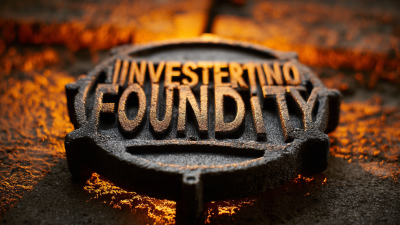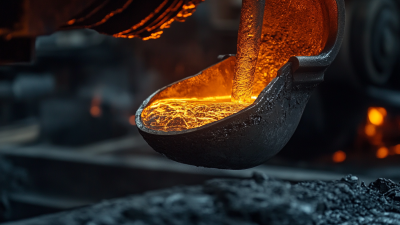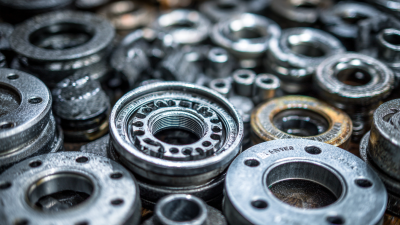In recent years, the manufacturing industry has witnessed a significant evolution in the casting process, primarily driven by the integration of advanced techniques and technologies. According to a report by the World Economic Forum, the global foundry market is projected to reach $172 billion by 2025, with a considerable portion attributed to improvements in casting efficiency and precision. Advanced casting process techniques, such as 3D printing and precision molding, have become critical not only for enhancing product quality but also for reducing production costs.

Moreover, a study conducted by the Casting Industry Suppliers Association reveals that manufacturers implementing modern casting processes can achieve up to 30% savings in costs and a 25% increase in overall production efficiency. These advancements not only streamline operations but also contribute to sustainability efforts by minimizing waste and optimizing resource usage. As industries continue to modernize, understanding the impact of these sophisticated casting techniques will be essential for manufacturers seeking competitive advantages in an increasingly complex marketplace.
Advanced casting techniques have transformed manufacturing processes, significantly reducing production times while maintaining high-quality standards. According to a report by the American Foundry Society, advanced casting methods such as 3D printing and vacuum casting can shorten lead times by up to 50%. This reduction is achieved through the ability to rapidly prototype and test designs without the extensive setup required by traditional casting methods.
Moreover, these innovative processes not only enhance speed but also enable more complex geometries that were previously impossible with conventional techniques. A study by the Metal Casting Industry highlighted that using advanced casting technologies allows manufacturers to achieve a 30% reduction in material waste, further contributing to cost savings. As companies increasingly adopt these methods, the overall manufacturing efficiency improves, allowing for more competitive pricing and faster market entry for new products. The integration of advanced casting processes represents a vital step towards optimizing production while keeping costs under control.
Innovations in casting processes are transforming manufacturing efficiency across various industries, particularly in aluminum casting and automotive production. The latest trends showcase how advancements like megacasting are streamlining operations, leading to significant cost reductions and production enhancements. Data from market analyses predict robust growth in the ductile and grey iron casting products market, with a significant surge anticipated by 2033 as industries adopt more efficient manufacturing processes and advanced materials.
 Tips: To leverage these advancements effectively, companies should invest in training their workforce alongside integrating new technologies, ensuring alignment between human skills and innovative machinery. Additionally, focusing on sustainability and environmental considerations during the transition can enhance an organization’s market position.
Tips: To leverage these advancements effectively, companies should invest in training their workforce alongside integrating new technologies, ensuring alignment between human skills and innovative machinery. Additionally, focusing on sustainability and environmental considerations during the transition can enhance an organization’s market position.
 The integration of innovative technologies is crucial for shipbuilding capacity as well. Recent proceedings highlight the necessity for investments in manufacturing technologies to achieve the desired production rates, suggesting a shift towards not just increased output but also overall operational efficiency. Companies venturing into these innovations are likely to see enhanced competitiveness and a stronger foothold in the global market.
The integration of innovative technologies is crucial for shipbuilding capacity as well. Recent proceedings highlight the necessity for investments in manufacturing technologies to achieve the desired production rates, suggesting a shift towards not just increased output but also overall operational efficiency. Companies venturing into these innovations are likely to see enhanced competitiveness and a stronger foothold in the global market.
Modern casting technologies play a critical role in enhancing manufacturing efficiency and achieving significant cost savings. By utilizing advanced techniques such as 3D printing, precision casting, and innovative mold design, manufacturers can streamline production processes and reduce material wastage. These modern methods allow for more intricate designs and tight tolerances, which can minimize the need for additional machining operations, further decreasing labor costs and turnaround times.
Moreover, investing in advanced casting techniques can lead to substantial reductions in operational costs. For instance, die casting and sand casting processes have evolved to incorporate automation and real-time monitoring systems, which enhance quality control and consistency. This reduction in defects means that manufacturers can save on rework and scrap, thereby lowering overall production costs. Through these innovations, companies not only improve their bottom line but also increase their ability to respond swiftly to market demands, thus maintaining a competitive edge in the industry.
This chart analyzes the cost savings achieved through various modern casting technologies including 3D printing, investment casting, and sand casting.
In the realm of manufacturing, the debate between traditional casting methods and advanced casting techniques is gaining momentum. Traditional casting, often characterized by sand molds and gravity-fed systems, has served industries for centuries. While effective, this method can be time-consuming and less precise, leading to higher scrap rates and increased costs. On the other hand, advanced casting techniques, such as 3D printing and vacuum casting, offer higher precision and reduced cycle times, significantly enhancing overall manufacturing efficiency.
**Tips:** When considering a transition to advanced techniques, it’s essential to evaluate your production volume and the complexity of the parts involved. Custom tooling and setups for advanced methods may require a higher initial investment, but the long-term savings and efficiency gains can be substantial.
Additionally, implementing hybrid approaches that combine both traditional and advanced methods can balance cost and efficiency. For example, using traditional casting for high-volume, simple geometries while deploying advanced techniques for complex, low-volume projects can optimize manufacturing processes. This comparative study underscores the need for manufacturers to assess their unique needs, ensuring they harness the best of both worlds for improved outcomes.

 Implementing advanced casting techniques is essential for enhancing production efficiency and achieving significant cost savings in the manufacturing industry. By utilizing methods such as precision casting, investment casting, and 3D printing, manufacturers can reduce material waste and improve the accuracy of their components. These techniques not only streamline the production process but also enable rapid prototyping, allowing for quicker iterations and adaptations based on real-time feedback.
Implementing advanced casting techniques is essential for enhancing production efficiency and achieving significant cost savings in the manufacturing industry. By utilizing methods such as precision casting, investment casting, and 3D printing, manufacturers can reduce material waste and improve the accuracy of their components. These techniques not only streamline the production process but also enable rapid prototyping, allowing for quicker iterations and adaptations based on real-time feedback.
Tip: To maximize the benefits of advanced casting techniques, consider investing in employee training programs focused on new technologies. Skilled workers can better operate sophisticated machinery, ensuring high-quality output and reducing error rates.
Moreover, embracing automation in the casting process can lead to more consistent results and faster turnaround times. Implementing smart manufacturing solutions, such as IoT sensors and AI-driven analytics, can also monitor production efficiency in real-time, identifying bottlenecks and suggesting improvements. This proactive approach to problem-solving helps maintain a smooth workflow and enhances overall productivity.
Tip: Regularly review and analyze production data to identify areas for improvement. This will not only help in optimizing existing processes but also in forecasting future needs and potential equipment upgrades.










